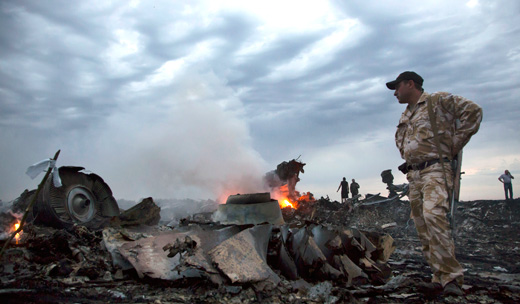
The crisis in Eastern Ukraine is coming to a head, with intensified fighting and mounting casualties, including many civilians. The conflict has made it difficult until now for an international technical team to reach the site of the shootdown of a Malaysian airliner which killed 298 people. Meanwhile, the government of President Petro Poroshenko has moved to suppress the Communist Party of Ukraine.
In February, the government of Victor Yanukovych of the Party of the Regions was overthrown by an uprising in Kiev, the capital. The original stated motive for the disturbances was that Yanukovych had stopped a planned agreement to bring Ukraine into closer relations with the European Union, and was favoring a trade bloc being pushed by Russian Federation President Vladimir Putin instead.
Other issues, including corruption, helped spark the protests. The arrival in Kiev of paramilitary forces with extremist right-wing leadership, close to political trends which had collaborated with Nazi Germany during World War II, signaled a sharp increase in violence and finally led Yanukovych to flee.
A new government was installed which was a coalition of right-wing and far-right wing elements, the latter including people with clearly fascist ideas. Arseny Yatsenyuk, the United States’ preferred candidate, became Prime Minister. But in Eastern Ukraine, site of the country’s major smokestack industries, the new government was not accepted as legitimate by most. The three easternmost oblasts (provinces) of Crimea, Luhansk and Donetsk, were most disaffected from the new regime. Locally organized referendums, not recognized by Kiev, led to the complete defection of Crimea which was quickly annexed to Russia, and autonomous local governments in Luhansk and Donetsk. The “people’s republics” of Donetsk and Luhansk began to dig in to resist.
A presidential election was carried out on May 25, under conditions which raised questions about its legitimacy. Violent threats and attacks led the Communist Party of Ukraine candidate, Piotr Symonenko, to withdraw from the race, and in some districts of the East the turnout was near zero. In the 2012 parliamentary elections, the Communist Party had come in fourth in the popular vote and had elected 32 deputies to the Rada, or parliament.
On July 22, the Rada rammed through a government sponsored law which requires the dissolution of any party faction (similar to a caucus in the United States Congress) which does not have sufficient members. As a number of the Communist Party’s deputies had previously resigned in a split, on July 24 the majority in the Rada declared the Communist Party grouping to be dissolved. The party is appealing this ruling in the courts, but at the same time the Parliament President, Oleksandr Turchynov, called for the Communist Party to be made illegal and communist ideology to be “abolished” in Ukraine.
Turchynov accuses the Communist Party of giving material and moral support to the “separatists” in Donetsk and Luhansk. Symonenko had said, during the presidential election campaign, that if he were elected the first thing he would do would be to withdraw the military forces that Kiev had sent to the east. Overall, the program of the Communist Party for dealing with the crisis has been to maintain a united Ukraine but on a highly federated basis in this exceedingly centralized country where governors are named from Kiev instead of elected by the people in their oblasts. Further, the power of the presidency would be greatly reduced or perhaps eliminated and that of the Rada increased. Relations with both the European Union and Russia’s trading bloc would be decided by plebiscite.
On the same day, Prime Minister Yastenyuk’s coalition in the Rada fell apart, with the defection of the fascist oriented Svoboda and center-right UDAR parties. Yatsenyuk promptly offered his resignation, but it was not accepted by the Rada. This presumably means that there must be an election in the coming months, but a date has not been set yet. Yatsenyuk will presumably stay on as caretaker prime minister until then.
The fighting in Eastern Ukraine has intensified with several towns falling to the Kiev government’s troops, while the cities of Donetsk and Luhansk are holding out. Civilian deaths have been pegged by the United Nations as 799 since April, with mounting damage to infrastructure. There have been many casualties, also, among fighters on both sides. The announcement by President Poroshenko of call up of reserves and the drafting of large new categories of men to fight in the east has led to antiwar protests in other areas of the country.
Meanwhile, the issue of the shooting down of the Malaysian airliner continues to be a complicating factor. Although it is still not clear who shot the plane down and under what circumstances, and at writing international observers had only just gained access to the site which is in an area of sharp armed conflict, the United States and its NATO allies have aligned themselves with Kiev’s version of events and have announced new sanctions against Russia.
Photo: At the Malaysian airliner crash site near the village of Hrabove, Ukraine, July 17. Dmitry Lovetsky/AP










